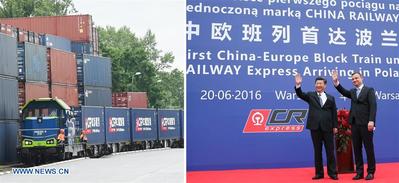 |
Chinese, Polish presidents highlight improved railway links.
Warsaw, Poland - June 20, 2016 - Combo photo shows Chinese President Xi Jinping and his Polish counterpart, Andrzej Duda (R), waving towards the first CHINA RAILWAY Express freight train as it arrives at the platform in Warsaw, Poland, on June 20, 2016.
Photo courtesy of Xinhua / Xie Huanchi, Lan Hongguang |
| |
Hong Kong Trade Development Council - July 24, 2018
The
Zhengzhou-Europe Railway aims to become part of the
Silk Road Economic Belt and establish logistics distribution networks both within
China and overseas.
It operates a balanced schedule of inbound and outbound trains as well as regular cold chain services.
It is now entering a new stage of development, with its
“one main line, three branch lines” multimodal transport system serving as a model for other
CR Express lines in the country.
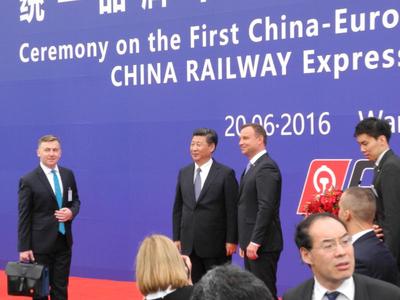 |
First China Railway Express arriving in Poland.
The first China – Europe container block train under the family brand “China Railway Express” arrived in Poland.
On 8 June the train set off from station in Chengdu, the capital of the Chinese province of Sichuan, then crossed the territories of Kazakhstan, Russia and Belarus and arrived 12 days later in Warsaw on 20 June 2016, where a solemn ceremony was organised attended by Chairman of the Chinese People’s Republic, Xi Jinping, President of the Republic of Poland, Andrzej Duda, heads of a number of ministries and railway administrations from both countries.
The ceremony was organised within the framework of an official visit of the Head of the Chinese People’s Republic to the Republic of Poland.
Photo courtesy of osjd.org |
| |
Zhengzhou is the capital city and economic hub of the central Chinese province of Henan.
In 2015,
China’s Central Government published the
Vision and Actions on Jointly Building the Silk Road Economic Belt and 21st Century Maritime Silk Road (or Belt and Road Initiative, BRI), which aims to encourage inland cities such as Zhengzhou to build international land ports in an effort to strengthen links with coastal and border ports over customs clearance issues.
To try to take advantage of the opportunities offered by the
BRI, the
Zhengzhou-Europe Railway – also known as the
China-Europe Railway Express (Zhengzhou) or
CR Express Zhengzhou – was launched.
The aim was to become part of the
Silk Road Economic Belt and establish logistics distribution networks both within
China and overseas.
Currently, the
Zhengzhou-Europe line operates a balanced schedule of inbound and outbound trains as well as regular cold chain services.
It is now entering a new stage of development, with its “one main line, three branch lines” multimodal transport system serving as a model for other
CR Express lines in the country.
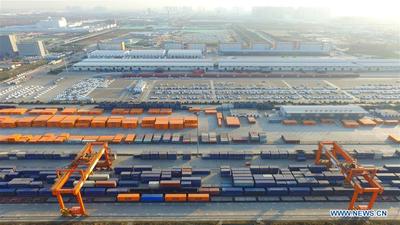 |
Containers are loaded to a freight train of China Railway Express at a railway container center in Zhengzhou, capital of central China's Henan Province, Dec. 25, 2017.
Photo courtesy of Xinhua |
| |
A New Overland Silk Road
CR Express trains operate on the
Chinese mainland via three routes: the west route through
Alataw Pass in Xinjiang, the central route through
Erenhot in Inner Mongolia, and the east route through
Manzhouli.
Zhengzhou-Europe trains start at Zhengzhou and pass through the two entry-exit ports of
Alataw Pass and
Erenhot, using the west and central routes.
The Zhengzhou-Europe line then passes through Kazakhstan, Mongolia, Russia, Belarus, Poland and Germany.
Along the way the trains go through customs twice and also switch tracks twice.
When the service was first launched,
Hamburg in Germany was the last stop.
In August 2017, a new line linking
Zhengzhou with Munich came on stream.
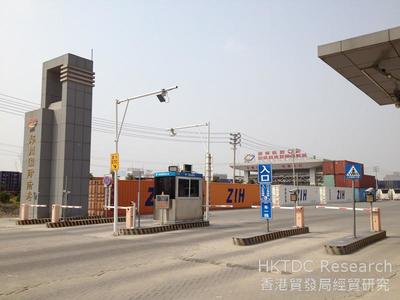 |
A CR Intermodal railway container centre at the Zhengzhou railway port.
Photo courtesy of HKTDC |
| |
Rail transport via the Zhengzhou-Europe line is faster than sea transport and cheaper than air.
It takes about
15 days from Zhengzhou to Germany via the Zhengzhou-Europe line - about three to four weeks less than travelling by the sea route.
The cost of railway transport is anywhere between 20% and 80% that of air transport, and the heavier the cargoes the bigger the saving.
The
Zhengzhou-Europe Railway is operated by the
Zhengzhou International Land Port Development and Construction Co Ltd (Zhengzhou Land Port) under a so-called “five fixed” business model (that is, fixed train stations, routes, numbers, schedule and price).
Although
Zhengzhou-Europe trains have yet to offer a customised service, they are the first
CR Express trains to provide a “door-to-door” delivery service by co-operating with domestic and foreign partners.
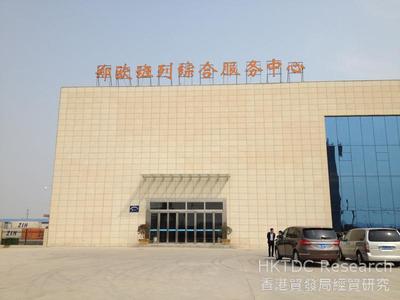 |
Zhengzhou-Europe Railway’s comprehensive service centre.
Photo courtesy of HKTDC |
| |
Balanced Train Schedule Tops China
The Zhengzhou-Europe line has been operating since July 2013.
In its early days, its trains mainly ran outbound.
But from 2015, the number of inbound trains began to increase until, by 2017, they had risen as a share of the total number of trains from 38% to 47%.
In 2017, there were eight outbound and eight inbound trains on the
Zhengzhou-Europe line each week.
A total of 501 trains ran between Zhengzhou and Europe in 2017, of which 266 were outbound and 235 were inbound, one of the most balanced schedules of inbound and outbound trains of all the China-Europe lines.
The Zhengzhou-Europe line plans to run 650 trains in 2018 and 1,000 trains by 2020.
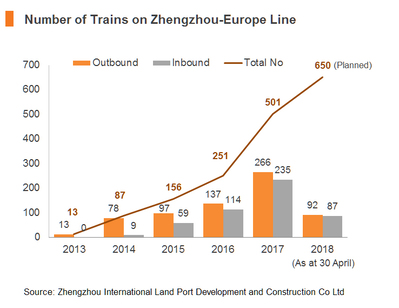 |
| Photo courtesy of HKTDC |
| |
The
Zhengzhou-Europe line is now ranked highest among all
CR Express lines in terms of the number of journeys, freight value, freight volume and full load rate.
The number of trains running on the
Zhengzhou-Europe line doubled from 2016 to 2017, reaching a total equivalent to that of its first four years of operation combined.
The total value of the freight transported on the line in 2017 was US$2.85 billion (HK$22.37 billion) and the total weight of the freight reached 297,000 tonnes.
1,008 trains had travelled on the Zhengzhou-Europe line between its opening in 2013 and the end of 2017, including 591 outbound and 417 inbound.
The total value of the freight carried over that period was US$5.32 billion and the total weight was 531,000 tonnes.
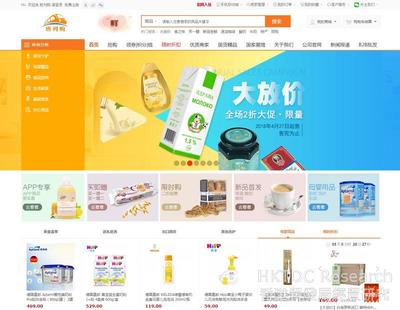 |
Online marketing: Banliegou.
Photo courtesy of HKTDC |
| |
Diversified Cargo Sources
The
Zhengzhou-Europe line carries a wide diversity of cargo types originating from many different parts of the country.
This reflects Zhengzhou’s geographical strength as a transport hub.
In 2017, according to
Zhengzhou Land Port, the main types of cargo carried on the line were machinery (which accounted for 26% of all outbound cargoes), garments (19%) and electronics (16%).
The majority of these outbound cargoes came from provinces and cities along
China’s east coast, such as
Zhejiang, Jiangsu, Shandong, Hebei, Tianjin and
Shanghai.
Some of the outbound cargoes also came from further afield in southern China.
10% originated from Guangdong and about 4% from Fujian.
Half of all the outbound cargoes were delivered to
Germany, while the rest went to other European countries including
Poland, Denmark, France, the Netherlands and
Switzerland.
Cargoes carried on the return trains consisted mainly of machinery (46%), whole vehicles and parts (16%), and iron and steel (12%).
Germany was the leading source of cargoes carried on the return trains, along with
Sweden, Italy, Poland, Denmark and
the Czech Republic.
About 20% of the inbound cargoes were destined for
Henan.
Other major destinations were cities and provinces in China’s eastern coastal region, including
Jiangsu, Shanghai and
Shandong.
While the
Zhengzhou-Europe line starts at Zhengzhou, only about 5% of outbound cargoes came from Henan itself.
At the other end of the route, cargoes also distributed to different countries in Europe, given its broad distribution network.
By the end of 2017,
Zhengzhou Land Port had set up branches and offices in 34 mainland cities while its overseas network covered
24 countries and 121 cities in Europe, Russia and
Central Asia.
With Henan province continuing to improve its port functions, the cargo sources of the
Zhengzhou-Europe line are bound to expand further.
Take the import of whole vehicles as an example.
Zhengzhou established a whole-vehicle entry port in 2014 which was designated in early 2018 as a vehicle parallel import pilot.
When the second phase of the whole-vehicle entry port is complete, Zhengzhou has the potential to become the largest imported vehicle display, trading and distribution centre in central China.
There are also other functional ports in Zhengzhou, including a designated port for imported meat products, a designated port for imported grains, the fourth national postal service port, and a pharmaceuticals entry port.
 |
Offline marketing: Zhengzhou-Europe Mall – Zhengzhou-Europe Railway Imported Commodities Display and Experience Centre.
Photo courtesy of HKTDC |
| |
O2O Marketing of Zhengzhou-Europe Line Imported Goods
As the
Zhengzhou-Europe line develops, it is not only providing a rapidly improving rail freight service, but is also branching out into product marketing by taking advantage of the regular high-frequency train services it offers.
Efforts have been made to integrate online and offline channels to market products imported via the
Zhengzhou-Europe trains.
The
B2B2C (business-to-business-to-consumer) e-commerce platform Banliego ( www.banliegou.com ), offering wholesale and retail services, was set up for general trade and cross-border trade.
Backed by cold chain transport and constant temperature storage, the products on offer are genuine, fresh and purchased at source.
The products promoted range from maternity and baby products, to food and beverages, and cosmetics.
Zhengzhou Land Port has also set up an offline marketing channel – the Zhengzhou-Europe Railway Imported Commodities Display and Experience Centre – displaying and selling a wide range of products imported via Zhengzhou-Europe trains.
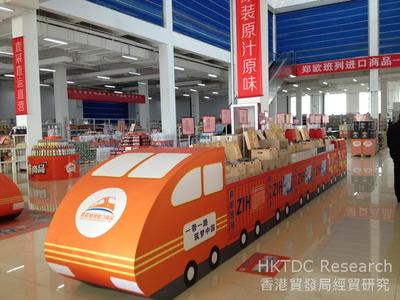 |
Imported goods promoted at the Zhengzhou-Europe Railway Imported Commodities Display and Experience Centre.
Photo courtesy of HKTDC |
| |
“Zhengzhou-Europe Railway + Cold Chain”
The cross-border railway transport service offered by the
Zhengzhou-Europe Railway is expanding rapidly, with its international cold chain logistics service taking a
leading position in China.
The
“Zhengzhou-Europe Railway + cold chain” global logistics solution, which went into service in May 2016, is currently the only regular cold chain service on
CR Express trains on the mainland.
The
Zhengzhou-Europe trains use proprietary constant temperature refrigerated containers, the temperature of which can be maintained at -18
oC during the summer and at 5
oC during winter time.
These refrigerated containers are equipped with GPS and a remote temperature control system which can carry out wireless remote monitoring of the containers, track their real-time location, temperature and humidity, and make appropriate adjustments remotely.
There is also a cold storage and a refrigerated storage at
Zhengzhou Land Port’s multimodal transport customs supervision centre, providing a storage environment with constant temperatures for imported products which have stringent needs regarding temperature control.
These include
food products, beverages and
electronics.
This service helps guarantee the quality and safety of the goods.
The cold chain logistics service offered by Zhengzhou-Europe trains is not limited to basic long-distance constant temperature cold storage.
Zhengzhou Land Port also tries to improve the information flow to its clients about its cold chain service.
In March 2017,
Zhengzhou Land Port’s cold chain transport integrated information service platform ( www.lengl.com ) was launched, providing one-stop real-time goods tracking, cargo source information, and other cold chain information dissemination services.
The
Zhengzhou-Europe Railway is helping to turn Zhengzhou into a mainland
CR Express hub and international cold chain logistics distribution centre.
 |
Imported German beer on sale at the Zhengzhou-Europe Railway Imported Commodities Display and Experience Centre.
Photo courtesy of HKTDC |
| |
One Main Line, Three Branch Lines
As China’s railway transport network comes of age,
CR Express lines operating in different mainland provinces are sparing no efforts in promoting links between various modes of transportation, including railway, highway, sea and air.
The integration of the railway network into the existing transport network is being accelerated.
However, given the different advantages of different provinces and cities, each region is creating a multimodal transport system with its own characteristics adapted to local conditions.
Chongqing is a case in point.
Situated in the interior of China’s central and western region, the municipality’s multimodal transport system, with the Chongqing-Xinjiang-Europe (or ‘Yuxinou’) International Railway as the trunk line, expands mainly southwards.
It will eventually link up with the
Silk Road Economic Belt and the
21st Century Maritime Silk Road in the south before connecting with markets in
Europe, Central Asia and
South-east Asia.
In contrast, Zhengzhou is closer to the coastal ports in the east – only 500 km, in fact, from the nearest port, Lianyungang in Jiangsu.
Zhengzhou is trying to capitalise on this proximity in its development of a multimodal transport system.
As well as building distribution networks in the mainland and in Europe, emphasis is also being placed on connecting the
Zhengzhou-Europe line with the eastern coastal ports, including
Qingdao, Lianyungang and
Tianjin.
Zhengzhou is also making use of multimodal transport to connect with
Busan and
Incheon in South Korea, and with
Tokyo and Osaka in Japan; and taking advantage of
China’s high-speed railway network by connecting the
Zhengzhou-Europe line with the
Beijing-Guangzhou Railway and
Lanzhou-Lianyungang Railway, in a bid to improve its domestic distribution network.
This unique multimodal “one main line, three branch lines” model, with
Zhengzhou-Europe as the main line and
Beijing-Guangzhou, Lanzhou-Lianyungang, and
Zhengzhou-Japan-Korea as the three branch lines, has won the approval of the government.
In the first batch of multimodal transport demonstration projects jointly announced by the
Ministry of Transport and the
National Development and Reform Commission in 2016, Zhengzhou’s “one main line, three branch lines” was one of the
16 selected projects.
By offering a balanced schedule of inbound and outbound trains and regular cold chain services, the
Zhengzhou-Europe Railway now serves as a model for
CR Express multimodal transport systems in the country.
Content provided by Doris Fung, Economist, HKTDC Research
Source: HKTDC Research
http://economists-pick-research.hktdc.com/business-news
ASTROMAN Magazine - 2018.07.11
The Asian Infrastructure Investment Bank (AIIB) to Transition to New Model For Project Approvals
https://www.astroman.com.pl/index.php?mod=magazine&a=read&id=2544
ASTROMAN Magazine - 2018.07.06
The third Belt and Road Summit Attracted 5,000 Participants, fostered concrete cooperation under the theme “Collaborate for Success”
https://www.astroman.com.pl/index.php?mod=magazine&a=read&id=2543
ASTROMAN Magazine - 2018.07.03
USD15 billion China-invested refinery and petrochemical complex seen as essential part of the economic future of Brunei
https://www.astroman.com.pl/index.php?mod=magazine&a=read&id=2538
ASTROMAN Magazine - 2018.06.18
The Belt and Road Blockchain Consortium: The Way Forward. The Belt and Road Summit 2018 in Hong Kong on 28 June, 2018
https://www.astroman.com.pl/index.php?mod=magazine&a=read&id=2533
ASTROMAN Magazine - 2018.06.11
A flagship Indonesian Belt and Road site, the Morowali Industrial Park, received an extra USD1.22 billion in mainland investment
https://www.astroman.com.pl/index.php?mod=magazine&a=read&id=2529
Editor-in-Chief of ASTROMAN magazine: Roman Wojtala, Ph.D.

